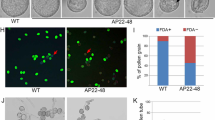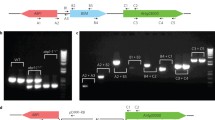Abstract
Six different mutations with defects in immature seed development have been identified during screening of a T-DNA collection of Arabidopsis thaliana. The mutations were confirmed to be monogenic and recessive-lethal by genetic analysis. Mutant embryos were blocked in certain steps in the process necessary for embryo viability and development, and therefore they belong to the embryo-lethal class of mutants. The genetic and morphological studies of T-DNA mutations affecting embryo development are presented. The youngest embryos with a defect were observed at the globular stage in the VIII-64 mutation. Externally located cells, precursor of the protoderm, were characterised by abnormal cell division. VIII-41 mutation with a defect at the late globular stage was arrested at the globular-heart stage transition. VIII-111 mutation showed defect at heart stage of embryogenesis with atypical development of cotyledon primordia. The defect was associated with abnormal pattern of cell division constituting the precursor of the shoot apical meristem. In VIII-82 mutation defect in torpedo stage with asymmetric cotyledons was observed. Cotyledon stage of embryos and chlorophyll defect were observed in VIII-75 mutant. Abnormal suspensor consisting of two columns of cells was observed in 280-4-4 mutation. Newly identified embryo-lethals can serve as starting material for more detailed genetic and molecular studies.
Similar content being viewed by others
References
Albert, S., B. Despres, J. Guilleminot, N. Bechtold, G. Pelletier, M. Delseny & M. Davic, 1999. The EMB 506 gene encodes a novel ankyrin repeat containing protein that is essential for the normal development of Arabidopsis embryos. Plant J. 17: 169–179.
Apuya, N.R., R. Yadegari, R.L. Fischer, J.J. Harada, J.L. Zimmerman & R.B. Goldberg, 2001. The Arabidopsis embryo mutant chlepperless has a defect in the Chaperonin-60 gene. Plant Physiol. 126: 717–730.
Brady, T. & E.D. Walthall, 1985. The effect of the suspensor and gibberellic acid on Phaseolus vulgaris embryo protein contents. Dev. Biol. 107: 531–536.
Chen, J.G., H. Ullah, J.C. Young, M.R. Sussman & A.M. Jones, 2001. ABP1 is required for organized cell elongation and division in Arabidopsis embryogenesis. Genes Dev. 15: 902–911.
Clark, J.K. & W.F. Sheridan, 1991. Isolation and characterization of 51 embryo-specific mutations in maize. Plant Cell 3: 935–951.
Despres, B., M. Delseny & M. Devic, 2001. Partial comple-mentation of embryo defective mutations: a general strategy to elucidate gene function. Plant J. 27: 149–159.
Franzmann, L.H., E.S. Yoon & D.W. Meinke, 1995. Saturating the genetic map of Arabidopsis thaliana with embryonic mutations. Plant J. 7: 341–350.
Gichner, T., S.A. Badayev, S.I. Demchenko, J. Relichová, S.S. Sandhu, P.D. Usmanov, O. Usmanova & J. Velemínský, 1994. Arabidopsis assay for mutagenicity. Mutation Res. 310: 249–256.
Grossniklaus, U., J.P. Vielle-Calsada, M.A. Hoeppner & W.B. Gagliano, 1998. Maternal control of embryogenesis by MEDEA,aPolycomb group gene in Arabidopsis. Science 280: 446–450.
Hobbie, L., M. McGovern, L.R. Hurwitz, A. Pierro, N.Y. Liu, A. Bandyopadhyay & M. Estelle, 2000. axr6 mutants of Arabidop-sis thaliana define a new gene involved in auxin response and early development. Development 127: 23–32.
Howell, S.H., 1998. Embryogenesis, pp. 55–82 in Molecular Ge-netics of Plant Development, edited by S.H. Howell. Cambridge University Press, Cambridge, UK.
Jűrgens, G., U. Mayer, R.A.T. Ruiz, T. Berleth & S. Misera, 1991. Genetic analysis of pattern formation in the Arabidopsis embryo. Dev. Suppl. 1: 27–38.
Mayer, U., R.A.T. Ruiz, T. Berleth, S. Misera & G. Jűrgens, 1991. Mutations affecting body organization in the Arabidopsis embryos. Nature 353: 402–407.
McElver, J., I. Tzafrir, G. Aux et al., 2001. Insertional mutagenesis of genes required for seed development in Arabidopsis thaliana. Genetics 159: 1751–1763.
Meinke, D.W., 1994. Seed development in Arabidopsis, pp. 253–295 in Arabidopsis thaliana, edited by E.M. Meyerowitz & C.R. Somerville. Cold Spring Harbor Press, Cold Spring Harbor, NY.
Meinke, D.M., 1995. Molecular genetics of plant embryogenesis. Annu. Rev. Plant Physiol. Plant Mol. Biol. 46: 369–394.
Motamayor, J.C., D. Vezon, C. Bajon, A. Sauvanet, O. Grandjean, M. M archand, N. Bechtold, G. Pelletier & Ch. Horlow, 2000. Switch (swi1), an Arabidopsis thaliana mutant affected in the female meiotic switch. Sex. Plant Reprod. 12: 209–218.
Műller, A.J., 1963. Embryonentest zum Nachweis rezessiver Letal-faktoren bei Arabidopsis thaliana. Biol. Zentralbl. 82: 133–163.
Patton, D.A., A.L. Schetter, L.H. Franzmann, K. Nelson, E. Ward & D.W. Meinke, 1998. An embryo-defective mutant of Arabidopsis disrupted in the final step of biotin synthesis. Plant Physiol. 116: 935–946.
Shevell, D.E., W.M. Leu, C.S. Gillmor, K.A. Feldmann & N.H. Chua, 1994. EMB 30 is essential for normal cell division, cell expansion, and cell adhesion in Arabidopsis and encodes a protein that has similarity to Sec7. Cell 77: 1051–1062.
Souer, E., A. van Houwelingen, D. Kloos, J. Mol & R. Koes, 1996. The No Apical Meristem gene of Petunia is required for pattern formation in embryos and flowers and is expressed at meristem and primordia boundaries. Cell 85: 159–170.
Souter, M. & K. Lindsey, 2000. Polarity and signalling in plant embryogenesis. J. Exp. Bot. 51: 971–983.
Springer, P., 2000. Gene Traps: tools for plant development and genomics. Plant Cell 12: 1007–1020.
Tanaka, H., B. Watanabe, D. Watanabe, T. Tanaka, C. Machida & Y. Machida, 2002. ACR4, a putative receptor kinase gene of Arabidopsis thaliana that is expressed in the outer cell layers of embryo and plants is involved in proper embryogenesis. Plant Cell Physiol. 43: 419–428.
Tanksley, S.D., M.W. Ganal & G.B. Martin, 1995. Chromosome landing: a paradigm for map-based gene cloning in plants with large genomes. Trends Genet. 11: 63–68.
Tsugeki, R., E.Z. Kochieva & N. Fedoroff, 1996. A transposon insertion in the Arabidopsis SSR16 gene causes an embryo-defective lethal mutation. Plant J. 10: 479–489.
Uwer, U., L. Willmitzer & T. Altmann, 1998. Inactivation of a glycyl-tRNA synthetase leads to an arrest in plant embryo development. Plant Cell 10: 1277–1294.
Vernon, D.M., M.J. Hannon, M. Le & N.R. Forsthoefel, 2001. An expanded role for the TWN1 gene in embryogenesis: defects in cotyledon pattern and morphology in the twn1 mutant of Arabidopsis (Brassicaceae). Am. J. Bot. 88: 570–582.
Yadegari, R., G. de Paiva, T. Laux, A.M. Koltunov, N. Apuya, J.L. Zimmerman, B. Fischer, J.J. Harada & R.B. Goldberg, 1994. Cell differentiation and morphogenesis are uncoupled in Arabidopsis raspberry embryos. Plant Cell 10: 1277–1294.
Yeung, E.C. & D.W. Meinke, 1993. Embryogenesis in angiosperms: development of the suspensor. Plant Cell 5: 1371–1381.
Zhang, J. & C.R. Somerville, 1997. Suspensor-derived polyem-bryony caused by altered expression of valyl-tRNA-synthase in the twn2 mutant of Arabidopsis. Proc. Natl. Acad. Sci. 94: 7349–7355.
Zhongsen, L. & T.L. Thomas, 1998. PEI1, an embryo-specific zinc finger protein gene required for heart-stage embryo formation in Arabidopsis. Plant Cell 10: 383–398.
Author information
Authors and Affiliations
Corresponding author
Rights and permissions
About this article
Cite this article
Kyjovská, Z., Řepková, J. & Relichová, J. New Embryo Lethals in Arabidopsis thaliana: Basic Genetic and Morphological Study. Genetica 119, 317–325 (2003). https://doi.org/10.1023/B:GENE.0000003744.39599.6d
Issue Date:
DOI: https://doi.org/10.1023/B:GENE.0000003744.39599.6d




